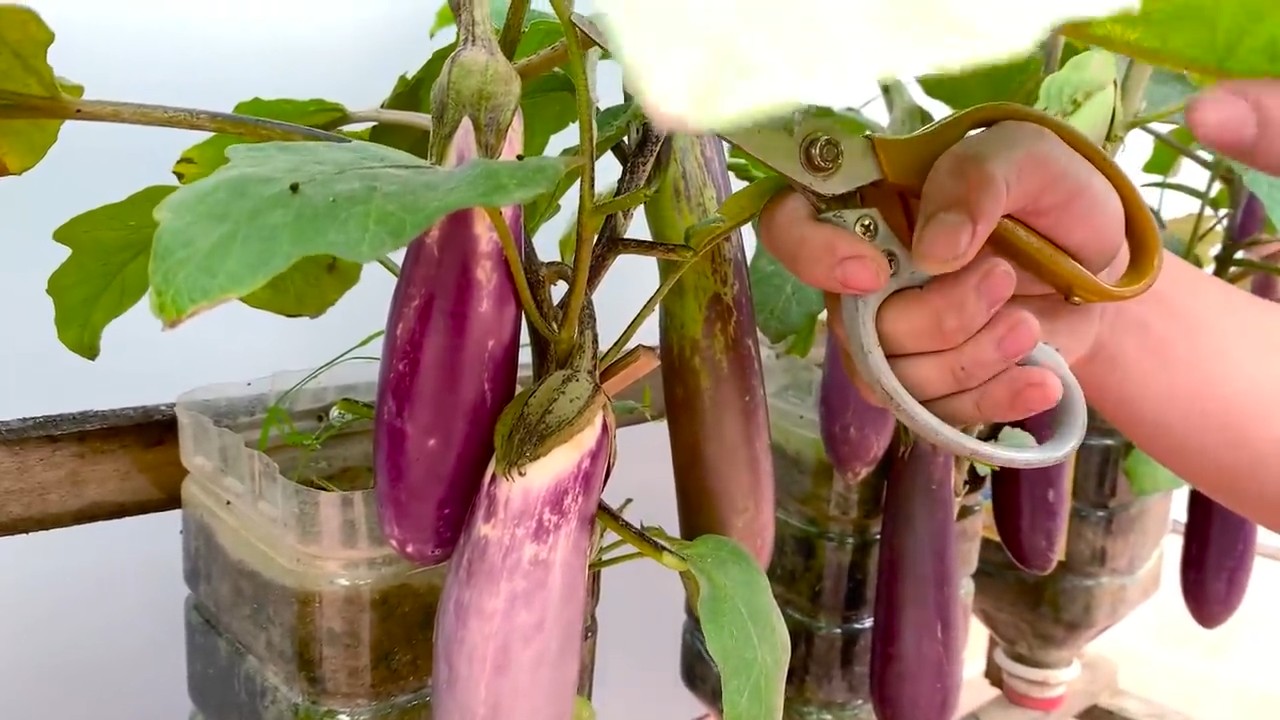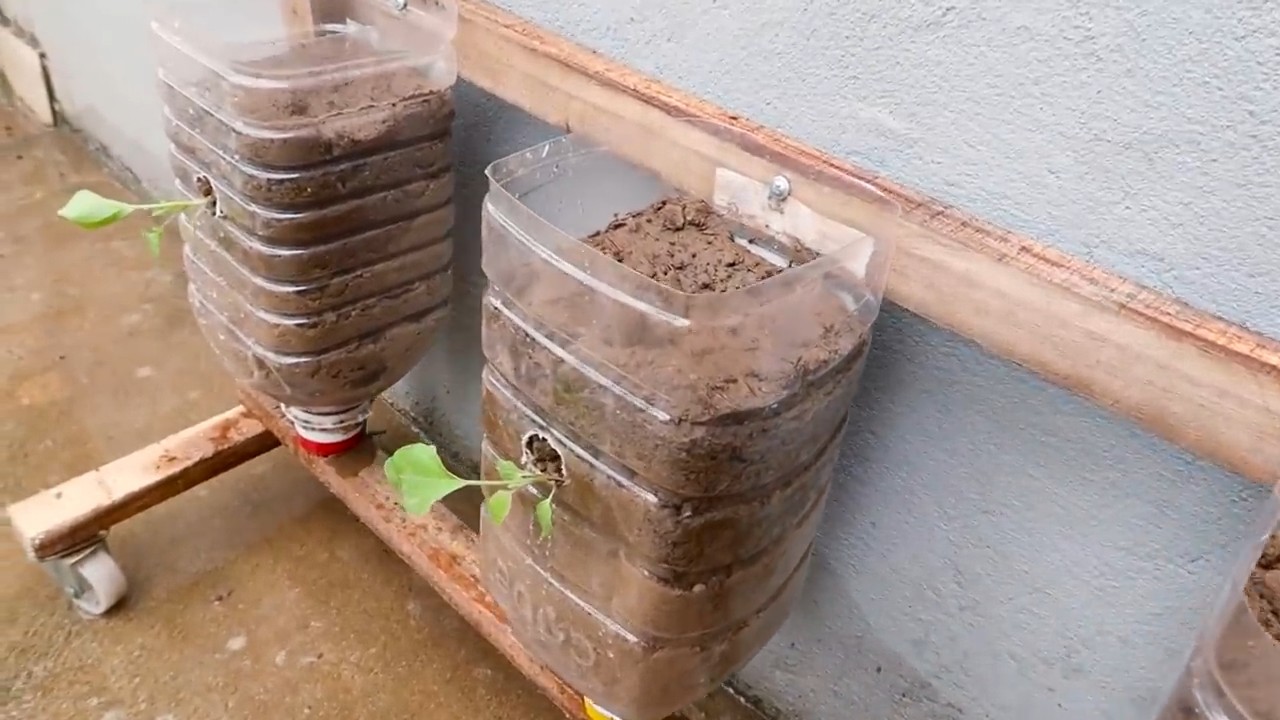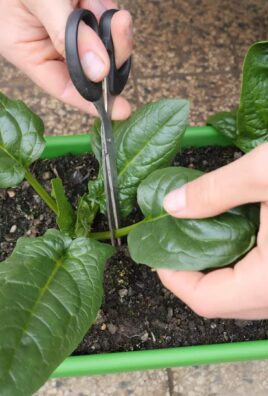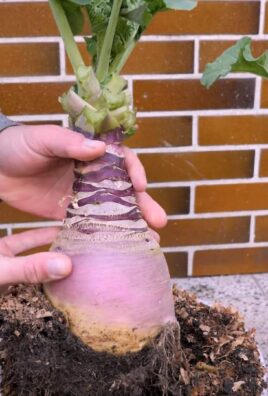Effortless eggplant growing – sounds like a dream, right? I know, I used to think so too! But trust me, with a few clever tricks and DIY hacks, you can transform your garden into an eggplant paradise, even if you’re a complete beginner. Forget struggling with stunted plants and disappointing harvests; this article is your guide to abundant, beautiful eggplants.
Eggplants, also known as aubergines, have a rich history, dating back thousands of years to ancient Asia. They were initially cultivated for their medicinal properties and ornamental value, and only later embraced as a culinary staple. Today, they’re a beloved ingredient in cuisines worldwide, from Mediterranean moussaka to Asian stir-fries. But growing them can sometimes feel like a battle against pests, diseases, and unpredictable weather.
That’s where these DIY tricks come in! Let’s face it, store-bought eggplants can be expensive, and nothing beats the taste of a freshly picked, homegrown vegetable. Plus, gardening is a fantastic way to de-stress, connect with nature, and enjoy the satisfaction of nurturing something from seed to table. This article will equip you with the knowledge and simple DIY solutions you need to achieve effortless eggplant growing, saving you time, money, and frustration. So, grab your gardening gloves, and let’s get started!

Effortless Eggplant Growing: A Beginner’s Guide to Bountiful Harvests
Hey there, fellow garden enthusiasts! Are you dreaming of plump, glossy eggplants gracing your dinner table? Well, you’ve come to the right place! I’m going to share my secrets to growing eggplants with minimal fuss and maximum yield. Forget the horror stories of finicky plants and disappointing harvests – with a little know-how, you’ll be swimming in eggplant parm in no time!
Choosing the Right Eggplant Variety
First things first, let’s talk varieties. Not all eggplants are created equal, and choosing the right one for your climate and space is crucial.
* Consider your climate: If you live in a cooler region with a shorter growing season, opt for early-maturing varieties like ‘Black Beauty’ or ‘Early Long Purple’. For warmer climates, you have a wider range to choose from, including the classic ‘Italian’ or the more exotic ‘Thai Green’.
* Think about space: Some eggplant varieties can get quite large, so if you’re gardening in containers or a small space, look for compact varieties like ‘Patio Baby’ or ‘Hansel’.
* Flavor preferences: Eggplants come in a variety of flavors, from mild and sweet to slightly bitter. Do some research and choose a variety that suits your taste buds. I personally love the ‘Listada de Gandia’ for its beautiful stripes and delicate flavor.
Preparing the Soil: The Foundation for Success
Eggplants are heavy feeders, meaning they need nutrient-rich soil to thrive. Before planting, it’s essential to prepare the soil properly.
* Soil Testing: Ideally, get your soil tested. This will tell you the pH and nutrient levels. Eggplants prefer a slightly acidic soil with a pH between 6.0 and 6.8.
* Amendments: Amend the soil with plenty of organic matter, such as compost, well-rotted manure, or leaf mold. This will improve drainage, aeration, and fertility. I like to add a generous amount of composted chicken manure for an extra boost.
* Well-Draining Soil: Ensure the soil is well-draining. Eggplants don’t like to sit in soggy soil, which can lead to root rot. If your soil is heavy clay, consider adding sand or perlite to improve drainage.
Starting Eggplants from Seed (or Buying Transplants)
You have two options: start your eggplants from seed indoors or buy transplants from a nursery. Starting from seed gives you more control over the process and allows you to choose from a wider variety of eggplants. However, it requires more time and effort.
Starting from Seed:
1. Timing is Key: Start your seeds indoors 6-8 weeks before the last expected frost. Eggplants need warm temperatures to germinate and grow.
2. Seed Starting Mix: Use a high-quality seed starting mix. Avoid using garden soil, as it can contain pathogens and weed seeds.
3. Planting the Seeds: Sow the seeds about ¼ inch deep in small pots or seed trays.
4. Warmth and Light: Keep the soil consistently moist and provide warmth (around 80-85°F) for germination. A heat mat can be helpful. Once the seedlings emerge, provide them with plenty of light. A grow light is ideal, but a sunny windowsill can also work.
5. Thinning: Once the seedlings have their first true leaves, thin them out, leaving only the strongest seedling in each pot.
6. Hardening Off: Before transplanting the seedlings outdoors, you need to harden them off. This means gradually exposing them to outdoor conditions over a period of 1-2 weeks. Start by placing them in a sheltered spot for a few hours each day, gradually increasing the amount of time they spend outdoors.
Buying Transplants:
1. Choose Healthy Plants: Select healthy-looking transplants with sturdy stems and green leaves. Avoid plants that are leggy, yellowed, or have signs of pests or diseases.
2. Check the Roots: Gently check the roots to make sure they are not root-bound. If the roots are circling the pot, gently loosen them before planting.
Planting Your Eggplants: Giving Them the Best Start
Whether you’re planting seedlings you started yourself or transplants from a nursery, proper planting is essential for success.
1. Timing: Wait until the danger of frost has passed and the soil has warmed up to at least 60°F before planting your eggplants outdoors.
2. Spacing: Space the plants 18-24 inches apart in rows that are 2-3 feet apart. This will give them enough room to grow and allow for good air circulation.
3. Planting Depth: Dig a hole that is slightly larger than the root ball of the plant. Gently remove the plant from its container and loosen the roots. Place the plant in the hole and backfill with soil, making sure the top of the root ball is level with the ground.
4. Watering: Water the plants thoroughly after planting.
5. Mulching: Apply a layer of mulch around the plants to help retain moisture, suppress weeds, and regulate soil temperature. I like to use straw or shredded leaves.
Caring for Your Eggplants: Nurturing Them to Maturity
Once your eggplants are planted, they need regular care to thrive.
* Watering: Water deeply and regularly, especially during hot, dry weather. Eggplants need consistent moisture to produce good fruit. Aim for about 1-2 inches of water per week.
* Fertilizing: Fertilize your eggplants every 2-3 weeks with a balanced fertilizer. You can also use a liquid seaweed fertilizer for an extra boost.
* Staking: As the plants grow, they may need to be staked to support the weight of the fruit. Use sturdy stakes and tie the plants loosely to the stakes with soft twine.
* Pruning: Pruning can help improve air circulation and encourage fruit production. Remove any suckers (small shoots that grow from the base of the plant) and any yellowed or damaged leaves.
* Pest and Disease Control: Keep an eye out for pests and diseases. Common eggplant pests include aphids, flea beetles, and spider mites. Diseases include verticillium wilt and blossom-end rot. Treat any problems promptly with appropriate organic pest control methods. I find that neem oil is effective against many common pests. For blossom-end rot, ensure consistent watering and add calcium to the soil.
Harvesting Your Eggplants: The Sweet Reward
Harvesting your eggplants at the right time is crucial for optimal flavor and texture.
1. Timing: Harvest the eggplants when they are glossy, firm, and have reached their mature size. The skin should be smooth and unblemished.
2. Testing for Ripeness: Gently press the skin of the eggplant. If it springs back readily, it’s ripe. If it feels hard and doesn’t give, it’s not quite ready.
3. Harvesting Technique: Use a sharp knife or pruning shears to cut the eggplant from the plant, leaving about an inch of stem attached.
4. Regular Harvesting: Harvest the eggplants regularly to encourage the plant to produce more fruit.
Troubleshooting Common Eggplant Problems
Even with the best care, you may encounter some problems while growing eggplants. Here are some common issues and how to address them:
* Blossom-End Rot: This is a common problem caused by calcium deficiency. The bottom of the eggplant will develop a dark, sunken spot. Ensure consistent watering and add calcium to the soil.
* Aphids: These small, sap-sucking insects can weaken the plant. Spray them with a strong stream of water or use insecticidal soap.
* Flea Beetles: These tiny beetles can chew holes in the leaves. Cover the plants with row covers or use neem oil.
* Verticillium Wilt: This fungal disease can cause the plant to wilt and die. Choose disease-resistant varieties and avoid planting eggplants in the same spot year after year.
Extending the Harvest: Keeping the Eggplants Coming
Want to enjoy eggplants for as long as possible? Here are a few tips for extending the harvest:
* Succession Planting: Plant new eggplant seedlings every few weeks to ensure a continuous supply of fruit.
* Cold Frames or Greenhouses: Use cold frames or greenhouses to protect the plants from frost and extend the growing season.
* Overwintering: In some climates, you can overwinter eggplant plants by bringing them indoors before the first frost. Cut back the plants and keep them in a cool, bright location.
Enjoying Your Harvest: From Garden to Table
Now for the best part – enjoying the fruits (or rather, vegetables!) of your labor! Eggplants are incredibly versatile and can be used in a wide variety of dishes.
* Roasting: Roasting eggplants brings out their sweetness and creamy

Conclusion
So, there you have it! Effortless eggplant growing is no longer a pipe dream but a tangible reality within your reach. We’ve unveiled a simple yet incredibly effective DIY trick that can transform your eggplant cultivation experience from frustrating to fulfilling. Forget battling pests, struggling with inconsistent watering, or watching your precious plants wither under the summer sun. This method offers a streamlined approach, promoting healthier, more productive plants with minimal effort.
Why is this a must-try? Because it addresses the core challenges of eggplant cultivation head-on. By creating a more controlled and supportive environment, you’re essentially giving your eggplants the VIP treatment they deserve. This translates to stronger root systems, increased resistance to diseases, and a significantly higher yield of those beautiful, glossy fruits we all crave. Imagine harvesting basketfuls of plump, delicious eggplants from your own garden, ready to be transformed into mouthwatering dishes. That’s the promise of this DIY trick.
But the beauty of this method lies not only in its effectiveness but also in its adaptability. Feel free to experiment with variations to suit your specific needs and preferences. For instance, if you live in a particularly hot climate, consider using a lighter-colored mulch to reflect sunlight and prevent the soil from overheating. You could also incorporate companion planting strategies, such as interplanting basil or marigolds, to further deter pests and attract beneficial insects. Another variation could involve using different types of containers, depending on the space you have available. From raised beds to large pots, the possibilities are endless. The key is to adapt the core principles of the DIY trick to your unique gardening situation.
We’re confident that this effortless eggplant growing method will revolutionize your gardening endeavors. It’s a game-changer for both seasoned gardeners and beginners alike. It simplifies the process, reduces the workload, and maximizes the rewards. So, what are you waiting for? Give it a try! Gather your materials, follow the steps outlined, and prepare to be amazed by the results.
More importantly, we want to hear about your experience! Share your successes, your challenges, and any modifications you make along the way. Your feedback is invaluable and will help us refine and improve this method for the benefit of the entire gardening community. Post your photos, share your tips, and let’s learn from each other as we embark on this journey of effortless eggplant growing together. Let’s cultivate a community of thriving eggplant gardens, one DIY trick at a time!
Frequently Asked Questions (FAQ)
What exactly makes this eggplant growing method “effortless”?
The term “effortless” refers to the reduced amount of time and labor required compared to traditional eggplant growing methods. This DIY trick typically involves optimizing soil conditions, water retention, and pest control through strategic techniques like mulching, container gardening, or specific watering schedules. While it still requires some initial setup and ongoing monitoring, the overall maintenance is significantly less demanding. It minimizes the need for constant weeding, frequent watering, and intensive pest management, allowing you to enjoy a bountiful harvest with less physical exertion.
What type of soil is best for this DIY eggplant growing trick?
Eggplants thrive in well-draining, fertile soil that is rich in organic matter. A slightly acidic to neutral pH (around 6.0 to 7.0) is ideal. Before planting, amend your soil with compost, well-rotted manure, or other organic amendments to improve its structure, drainage, and nutrient content. If you’re using containers, choose a high-quality potting mix specifically formulated for vegetables. Avoid heavy clay soils, as they can become waterlogged and hinder root development. A soil test can help you determine the specific nutrient deficiencies in your soil and guide you in making the necessary amendments.
How often should I water my eggplants using this method?
Watering frequency depends on several factors, including the climate, soil type, and the size of your plants. However, a general rule of thumb is to water deeply and less frequently, rather than shallowly and often. Aim to keep the soil consistently moist but not waterlogged. Check the soil moisture level by inserting your finger about an inch deep. If it feels dry, it’s time to water. Mulching around your plants can help retain moisture and reduce the need for frequent watering. During hot, dry periods, you may need to water more frequently. Container-grown eggplants typically require more frequent watering than those grown in the ground.
What are some common pests and diseases that affect eggplants, and how can I prevent them using this DIY trick?
Common eggplant pests include aphids, flea beetles, spider mites, and tomato hornworms. Diseases include fungal issues like early blight, verticillium wilt, and blossom-end rot. This DIY trick can help prevent these problems by promoting healthy plant growth, which makes them more resistant to pests and diseases. Proper soil drainage and air circulation are crucial for preventing fungal diseases. Companion planting with herbs like basil or marigolds can deter pests. Regularly inspect your plants for signs of pests or diseases and take action promptly. Organic pest control methods, such as insecticidal soap or neem oil, can be effective in controlling infestations. Ensuring adequate calcium levels in the soil can help prevent blossom-end rot.
Can I use this DIY trick for growing eggplants in containers?
Absolutely! In fact, container gardening is an excellent way to implement this DIY trick, especially if you have limited space or poor soil conditions. Choose a container that is at least 12 inches in diameter and depth to accommodate the eggplant’s root system. Use a high-quality potting mix and ensure that the container has adequate drainage holes. Container-grown eggplants tend to dry out more quickly than those grown in the ground, so monitor the soil moisture level regularly and water accordingly. You may also need to fertilize more frequently, as nutrients can leach out of the container over time.
What are some good companion plants for eggplants?
Companion planting can be a valuable tool for enhancing eggplant growth and deterring pests. Some excellent companion plants for eggplants include basil, marigolds, thyme, rosemary, and oregano. Basil repels many common eggplant pests, while marigolds attract beneficial insects that prey on pests. Thyme, rosemary, and oregano also have pest-repelling properties. Additionally, beans and peas can help fix nitrogen in the soil, benefiting eggplant growth. Avoid planting eggplants near fennel, as it can inhibit their growth.
How long does it take for eggplants to mature and produce fruit using this method?
The time it takes for eggplants to mature and produce fruit depends on the variety, climate, and growing conditions. Generally, it takes about 60 to 80 days from transplanting to harvest. This DIY trick can potentially shorten the time to harvest by promoting faster growth and healthier plants. Provide your eggplants with plenty of sunlight, water, and nutrients to encourage fruit production. Harvest the fruits when they are glossy, firm, and have reached their mature size.
What if I live in a colder climate? Can I still use this DIY eggplant growing trick?
Yes, you can still use this DIY trick in colder climates, but you may need to take some additional precautions. Start your eggplant seeds indoors 6 to 8 weeks before the last expected frost. Use grow lights to provide adequate light for the seedlings. Harden off the seedlings gradually before transplanting them outdoors. Choose a sunny, sheltered location for your eggplant plants. Consider using row covers or cloches to protect the plants from frost and extend the growing season. You can also grow eggplants in containers and move them indoors during cold snaps. Select eggplant varieties that are known to be more cold-tolerant.
How can I tell when my eggplants are ready to harvest?
Eggplants are typically ready to harvest when they are glossy, firm, and have reached their mature size. The skin should be smooth and unblemished. Gently press the fruit with your thumb; if it gives slightly, it’s ripe. Overripe eggplants can become bitter and seedy. Use a sharp knife or pruning shears to cut the fruit from the plant, leaving a short stem attached. Harvest eggplants regularly to encourage continued fruit production.
Can I save seeds from my eggplants to plant next year?
Yes, you can save seeds from your eggplants, but keep in mind that hybrid varieties may not produce true-to-type offspring. To save seeds, allow the fruit to fully mature on the plant until it becomes dull and slightly soft. Cut the fruit open and scoop out the seeds. Rinse the seeds thoroughly to remove any pulp. Spread the seeds out on a paper towel to dry completely. Store the dried seeds in an airtight container in a cool, dark, and dry place. Label the container with the variety and date.




Leave a Comment